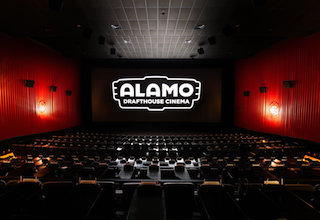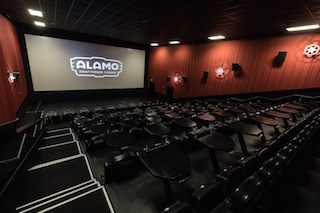 Mark Louis is Alamo Drafthouse Cinemas director of presentation. In that role, he is responsible for maintaining the level of technology that has become central to the exhibitor’s brand and identity. Louis is currently overseeing the opening of seven new Alamo theatres across the United States, while simultaneously maintaining the quality control of the established sites. When I contacted him to talk about how he approaches new builds he described himself as “busier that a one-armed reel-to-reel projectionist,” but he agreed to talk via email. Here’s an excerpted version of our conversation.
Mark Louis is Alamo Drafthouse Cinemas director of presentation. In that role, he is responsible for maintaining the level of technology that has become central to the exhibitor’s brand and identity. Louis is currently overseeing the opening of seven new Alamo theatres across the United States, while simultaneously maintaining the quality control of the established sites. When I contacted him to talk about how he approaches new builds he described himself as “busier that a one-armed reel-to-reel projectionist,” but he agreed to talk via email. Here’s an excerpted version of our conversation.
Digital Cinema Report: How many locations does Alamo Drafthouse currently operate?
Mark Louis: We have 41 theatres in 10 states.
DCR: Where are the seven new theatres located?
ML: Brooklyn, Manhattan and Staten Island, New York; Cedar Park and East El Paso, Texas; Crystal City, Virginia; and Orlando, Florida.
DCR: Are these new builds or renovations of existing theatres?
ML: Five of the new 2020 venues are new builds. The theatres in Brooklyn and Manhattan are renovations of existing buildings.
DCR: How does your approach differ with new builds versus renovations?
ML: Building theatres in existing buildings creates unique challenges to a design that meets Alamo's high standards. A few examples are our strict adherence to proper image aspect ratios, the requirement of moveable screen masking and zero compromises on auditorium site lines. In other words, we're incorporating our presentation standards in an existing space. When we build from the ground up, we can start with presentation standards and build around those.
 DCR: What are the first steps you take when considering a new location?
DCR: What are the first steps you take when considering a new location?
ML: Not really my area but I can say we do the typical market, location and access studies. We also have a really good idea of the type area where an Alamo typically does well and the type of community that we can successfully engage.
DCR: Who handles theatre design for you?
ML: We have our own in-house construction and design department but we always use a select few outside consultants and architects for every project.
DCR: What’s the typical timeframe for opening a new Drafthouse?
ML: This varies greatly from one project to the next so there is no typical timeline. Due to things like unique designs for every Alamo, our community conscious approach to construction and design, our rules for not opening the doors until we have a finished product and fully trained staff, etc., our timelines shift for almost every project.
DCR: What technology are you installing in the new theatres?
ML: Our two current digital cinema projector brands are Sony and Barco. Our 35mm projectors are Simplex or Century. Playback servers are either Sony or GDC, and at our Los Angeles location we have installed GDC's CA 2.0 content streaming system. Our brand standard for sound systems is QSC with an emphasis on the advantages and flexibility that Qsys provides. Two of our locations so far incorporate HDMI over IP systems provided by Visionary Solutions, which has opened up many more [event cinema] possibilities.
We're also in the process of testing new Assistive Listening/Closed Captioning systems to provide our guests more options including signing display and multi-language support.
 DCR: What newly introduced digital cinema technology interests you the most?
DCR: What newly introduced digital cinema technology interests you the most?
ML: I'm actually very interested in the new Series 3, smaller TI chip, 4K DLP RGB Laser projectors. Their smaller form factor, air cooling (avoiding the need for chillers) and lower cost makes them a much more viable, high quality option. We will be installing the new Series 3, Barco SP-4K Laser projectors in our Brooklyn expansion project. I'm also very excited by the new HDMI over IP, A/V distribution systems that give us much more versatility in showing alternative content in our theatres. Our newly opened Los Angeles location has this type of system, which is the first of its kind that I know of in the cinema space. There we have an HDMI over IP system, which integrates QSC Qsys with Visionary Solutions.
DCR: What do you think of Samsung’s Onyx LED Cinema Screen?
ML: I definitely believe it has its place in cinema but we have to be careful on how it's sold and how it's utilized. When it comes to standard cinema, I've always been a firm believer in promoting the differentiators of the movie theatre experience compared to home viewing so we can't let people think they're just going to see a big TV set. Its high dynamic range capability including infinite contrast is definitely worth promoting. Another advantage of the Onyx is the added versatility and increased quality it offers for alternative content. At Alamo, alternative content, auditorium rentals and special events are a big part of our business and having a top quality image with full contrast no matter the stray light level in the auditorium could be huge.
DCR: Have you installed ScreenX or anything comparable? Any plans to do so?
 ML: We have not installed ScreenX and do not have plans to do so at this time. It doesn't quite fit our model of what we believe the true movie going experience to be. However, it might be worth considering at some point to enhance our custom pre-shows and special events.
ML: We have not installed ScreenX and do not have plans to do so at this time. It doesn't quite fit our model of what we believe the true movie going experience to be. However, it might be worth considering at some point to enhance our custom pre-shows and special events.
DCR: Any changes to your basic technology package?
ML: We recently made a change to Qsys sound processing and instituting HDMI over IP A/V systems. Also, due to booth access restrictions in some of our recent new venues, we've incorporated more remote A/V control capability than ever before. Even with more automation being added to our booth operations, we still employ projectionists at every venue, for it is vital to maintaining our commitment to showmanship that Alamo considers job one.
DCR: These next two questions are a bit out of your area of responsibility but, if you could, I’d like to know your thoughts? In the past Alamo has worked with streaming companies like Netflix and Amazon. Do you think those relationships will expand in 2020?
ML: I can't really speak to this too much since as you know, it is a very hot potato. I can say that personally, I'm excited by the possibility of getting access to more premium content than ever before.
DCR: Your membership program, Alamo Season Pass, is still in beta. What has been the response?
ML: Season Pass is now available to everyone in Austin, Denver, Raleigh, Yonkers and Kansas City and will be coming off beta across all of our theatres very soon. It’s been a success. Our guests are really enjoying it and we enjoy seeing them in our theatres more often.
